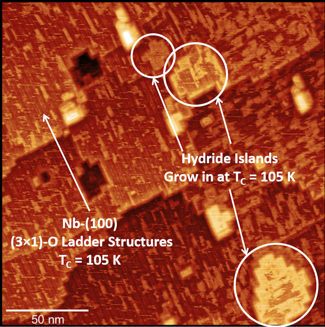Nano-hydride formation on niobium surfaces
Recent work has revealed the importance of hydride formation on the cavity quality factor (Q) of niobium (Nb) superconducting radio frequency (SRF) accelerator cavities. At operating temperatures, hydrogen incorporated into the bulk of Nb cavities segregates into surface hydride species, which have been shown to quench superconducting behavior. In an effort to clearly understand the mechanisms of Nb hydride growth, we have investigated Nb(100) samples doped with H2 in situ, and analyzed the hydrogen doped Nb(100) sample under ultra-high vacuum (UHV) conditions using scanning tunneling microscopy (STM) and scanning tunneling spectroscopy (STS).
This work has revealed the initial growth rate of Nb hydrides to be on the time scale of angstroms (Å) per hour at Tsample = 105 K and revealed the surface evolution of hydride formation at the atomic scale. We have also utilized STS to understand the electronic density of states of the native Nb(100) (3x1)-O surface and Nb hydrides, and have observed a distinct difference in band gap between the two species. Recent results from Fermi National Accelerator Laboratory have revealed the beneficial effects of nitrogen doping on SRF cavity performance. To definitively determine any nano and atomic scale effects nitrogen doping has on Nb hydride growth, ongoing studies are focused on STM imaging to compare Nb hydride growth behavior to Nb samples doped with both hydrogen and nitrogen.


